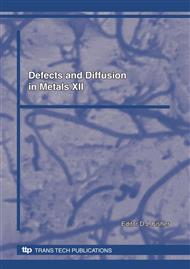p.49
p.55
p.61
p.71
p.85
p.89
p.95
p.105
p.109
Studies of the EPR Parameters and Local Structure for the Cu2+ Center in Lanthanum Magnesium Nitrate
Abstract:
The electron paramagnetic resonance parameters (g-factors and the hyperfine structure constants) for the Cu2+ center in lanthanum magnesium nitrate (LMN) are theoretically studied from the conventional perturbation formulas of these parameters for a 3d9 ion in tetragonally elongated octahedra. The studied complex is found to exhibit the slight tetragonal elongation (characterized by the relative elongation ratio ρ 4%) due to the Jahn-Teller effect, which may entirely conceal the original trigonal distortion of the host Mg2+ site in LMN. The conventional formulas containing only the metal orbital and spin-orbit coupling contributions are proved to be valid for the Cu2+ center in view of the weak covalency and ligand spin-orbit coupling interactions. This defect is also compared with the similar Cu2+ center of the Jahn-Teller nature on the octahedral interstitial site in the CdSe nanocrystals.
Info:
Periodical:
Pages:
85-88
Citation:
Online since:
October 2010
Authors:
Price:
Сopyright:
© 2010 Trans Tech Publications Ltd. All Rights Reserved
Share:
Citation:


